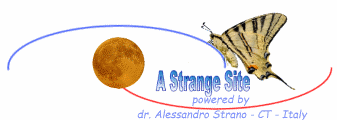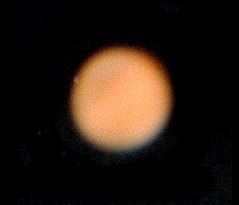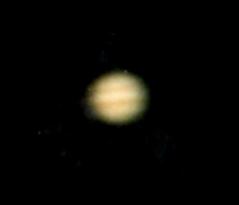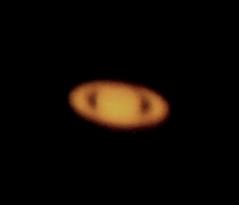The Solar System.
The solar system comprises the Sun and eight planets (1) which are: ( in order of distance of our star) Mercury, Venus, Earth, Mars, Jupiter, Saturn, Uranus and Neptune. Planets turn on their axis (rotation) and round the Sun (revolution) drawing, as say the first law of Kepler, ellipse of which the Sun occupies one of the two focuses. In fact, the word planet derives from the Greek language and means "errant" because, in the sky at night, planets seem to wander among stars.
The ancients built many cosmologies but their contents were mythological. It was the Greek Talete who investigated the nature of the universe trying to explain some phenomena; for example, he understood the mechanism of eclipses. There were also people who affirmed that the Earth and the luminaries were spherical and that was not the Earth in the center of the cosmos but Zeus's fire, but that was due to beliefs of Pythagoreans. However, for many centuries, people shared the system built by Tolomeo (I-II century A.D.), in it the Earth was in the center while the Sun and planets (Mercury, Venus, Mars, Jupiter and Saturn) turned round the Earth drawing circular orbits; exactly planets turned according to an epicycle where center was equidistant from the Earth. Names of days of the week depend to that system too. Copernicus (XV-XVI century A.D.) used it too but made a fundamental change: he put the Sun in the center, not the Earth. The theory of epicycles continued to be shared because the use of circular orbits gave inexplicable errors in ephemeredes. It was necessary waiting for the work of Kepler (XVI-XVII century A.D.) to get a correct representation of orbits that really are elliptical and not circular. With the progress of technology many other plugs have been added: in 1610, Galileo Galilei in "Sidereus nuncius" wrote about satellites of Jupiter and sunspots; in 1781, Herschel discovered Uranus; in 1846, Galls discovered Neptune; in 1930 Tombaugh discovered Pluto (1). However researches are not completed and every day we learn a bit more.
The Numbers of the Solar System.
|
Planet (photos by Giuseppe Petralia) |
average distance from Sun (Earth=1) |
Period of rotation | Period of sidereal revolution (Earth=1) |
Mass (Earth=1) |
Atmosphere | ||||||
|
Mercury |
|
0,39 |
59d |
0,24 |
0,06 |
it has not atmosphere |
|||||
|
Venus |
|
0,72 |
243d |
0,62 |
0,82 |
carbon dioxide, azote |
|||||
|
Earth |
1(149,6 million km) |
23h 56m 4s |
1 (365,26d) |
1 (5,97*1024 kg) |
azote, oxygen |
||||||
|
Mars |
|
1,52 |
24h 37m 23 sec |
1,88 |
0,11 |
carbon dioxide, azote |
|||||
|
Jupiter |
|
5,20 |
9h 50m 30s |
11,86 |
317,9 |
hydrogen, helium |
|||||
|
Saturn |
|
9,54 |
10h 14m |
29,46 |
95,2 |
hydrogen, helium |
|||||
|
Uranus |
19,18 |
17h |
84,01 |
14,6 |
hydrogen, helium |
||||||
|
Neptune |
30,06 |
14h |
164,8 |
17,2 |
hydrogen, helium |
||||||
Mercury and Venus are also called "internal planets" because their orbits are within that of the Earth. Venus and Uranus have a retrograde rotation. Density (kg/dm3) of Jupiter, Saturn, Uranus and Neptune is about one fifth of other planets ones because their structure is in large part of gaseous nature. See also the Ephemerides page.
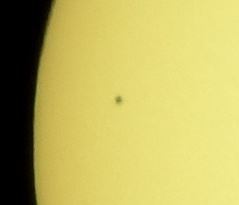
Mercuryduring the transit in front of the Sun of 09 May 2016
photo by Alessandro Strano
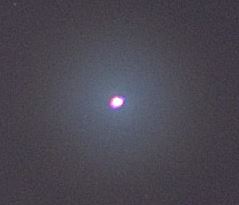
Venus at the sunset
photo by Alessandro Strano
The Solar System: the Moon.

photo by Giuseppe Petralia
The Earth has one satellite, the Moon: its average distance from our planet is 384.000 km, a lunation (that is the time between two next and equal phases) is about 29d 12h 44m while its mass is 1,2% of the Earth one. The gravity of the Moon causes tides.
Lunar Eclipses.
Lunar eclipses happen when the Earth is between Sun and Moon and this can happen only when the Moon (in full phase) is near one of its two orbital nodes (the points where lunar orbit intersects the earth's orbit). During the eclipse the Moon is generally visible; indeed sunbeams are diffused by the atmosphere, but short waves become weak while long waves (red) reach the Moon, so our satellite appears reddish. A lunar eclipse can last about 3,5 hours. There are about 1,5 lunar eclipses in a year.
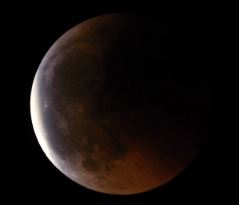
The Moon during the eclipse on 15 June 2011
photo by Alessandro Strano
The Solar System: the Sun.

photo by Alessandro Strano
Our star is a "yellow dwarf " but, though it is little compared with other stars, its diameter is 109 times bigger than Earth one. Its superficial temperature is 5512 Celsius. The Sun is made of hydrogen and helium and it is the process of fusion of hydrogen into helium which produces energy. Light emitted by the Sun reaches the Earth after 8 minutes, in other words the Sun we see is that of eight minutes before; velocity of light is about 300.000 km/s. See also the Sun-light web page.
Solar Eclipses.
Solar eclipses happen when the Moon is between Earth and Sun and this can happen only when the Moon (in new phase) is near one of its two orbital nodes (the points where lunar orbit intersects the earth's orbit). A solar eclipse can last about 8 minutes. There are about 2,3 solar eclipses in a year.
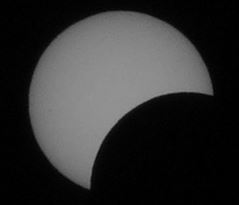
The Sun during the eclipse on 29 March 2006
photo by Carmelo Cavallaro
The Sun is only one of the many stars in the universe. Let us get a look at the sky in a neat night: we will see many stars. In this photo we can see some stars; the three brightest ones are called the "Belt" of Orion. See also the page dedicated to the Stars and Constellations.
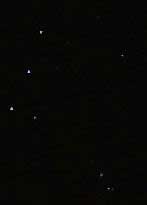
photo by Alessandro Strano
(1) With the IAU resolution dated 26 August 2006, which gave the "definition of planet", Pluto was not consider properly a planet any longer.
